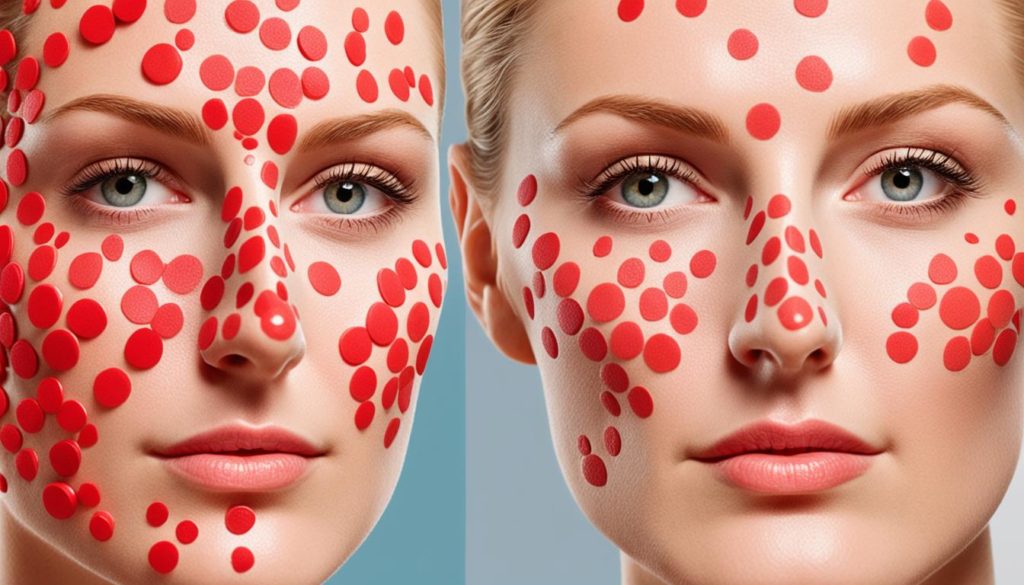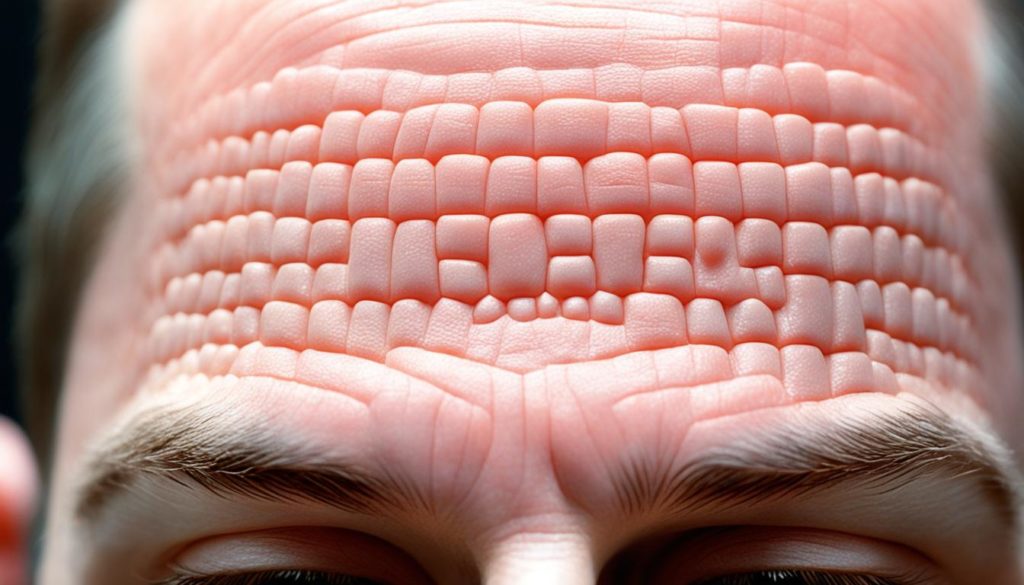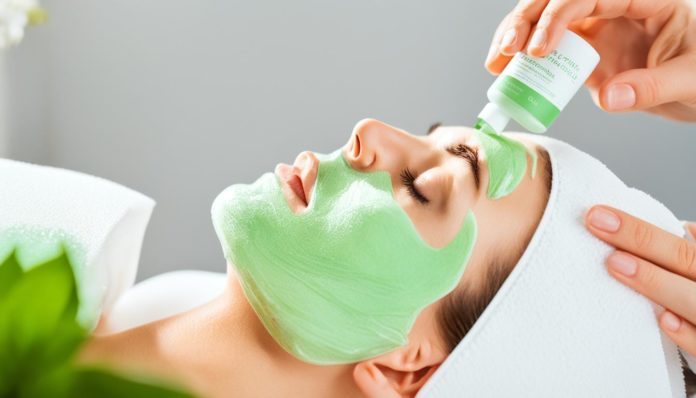Did you know up to 56% of individuals thinking they have bacterial acne are wrong? They’re actually facing fungal acne. This skin issue is hard to spot because it looks like regular acne. Yet, it’s caused by yeast. Knowing the details about fungal acne is key for handling it right.
Fungal acne isn’t as well-known as standard acne, making it tricky. Getting the right diagnosis from a skin doctor is a game-changer. It helps pick the best treatment. But if it’s misunderstood, it leads to treatments that don’t work. This can be really upsetting and uncomfortable.
Fungal acne is officially called Malassezia Folliculitis by skin experts. Treating it is different from how you’d tackle bacterial acne. It’s important to understand yeast’s role in causing it. Adjusting how you care for your skin is a crucial part of treatment.
Key Takeaways
- Fungal acne affects up to 56% of people misdiagnosed with bacterial acne.
- Proper diagnosis is crucial for effective treatment and management.
- Fungal acne, or Malassezia Folliculitis, is caused by yeast.
- Specialized skincare routines are necessary to manage symptoms.
- Consulting a dermatologist can prevent misdiagnosis and guide appropriate treatments.
What is Fungal Acne?
Fungal acne, often mixed up with bacterial acne, comes from too much yeast growth in hair follicles. Specifically, it’s caused by yeast types like Malassezia or Pityrosporum. Knowing how fungal acne is different is key to treating it right.
Definition
Fungal acne isn’t really acne but a kind of folliculitis. It happens when there’s more yeast in the skin, not bacteria. It shows up as tiny, red bumps that itch a lot.
Differences from Bacterial Acne
Fungal and bacterial acne look and start differently. Bacterial acne comes from bacteria, causing big, sore pimples. Fungal acne starts with a yeast overload and won’t get better with usual acne creams. It needs antifungal treatment instead.
| Characteristics | Fungal Acne | Bacterial Acne |
|---|---|---|
| Cause | Yeast (Malassezia) | Propionibacterium acnes |
| Appearance | Small, itchy, uniform red bumps | Varied inflammation, pus-filled pustules |
| Treatment | Antifungal agents | Acne treatments like benzoyl peroxide |

Common Misconceptions
Many myths about fungal acne lead to wrong diagnosis. Some think it’s due to bad hygiene. In truth, lifestyle more likely upsets the skin’s yeast balance. Others confuse it with tough bacterial acne, causing wrong treatment choices. It’s vital to challenge these myths for correct diagnosis and care, making sure it’s not mixed up with similar skin issues.
Fungal Acne Symptoms
Knowing the Early Signs of Fungal Acne helps you act fast. Spotting symptoms early means you can stop them from getting worse. We’ll look at signs of fungal acne, how to spot them, and why seeing a doctor matters.
Signs to Look For
If you feel itchy and see small, red bumps on your forehead, chest, or back, pay attention. These bumps might be filled with pus and are usually close together. They look a lot like regular acne but are different because they come from yeast overgrowth, not bacteria.
This is why knowing the difference is key to treating them right.
Visual Identification
Looking closely at the skin can help identify fungal acne. The bumps have a uniform look, are red, and often grouped together. They are about 1-2 mm wide and might have whiteheads.

A picture can help tell fungal acne apart from other kinds. It’s wise to check with a skin doctor for expert advice.
When to See a Dermatologist
If your acne doesn’t improve with regular treatments, seek dermatology expert advice. Getting a Malassezia Folliculitis Diagnosis is crucial. Dermatologists use special tools to tell fungal acne apart from other skin issues, making sure you get the right treatment.
Seeing a doctor early can avoid worse skin problems and ease your symptoms.
Fungal Acne Causes
It’s key to know what causes fungal acne to manage and stop it. Many factors, including yeast and life habits, affect it a lot.
Underlying Factors
Some health issues can trigger fungal acne. Risk is higher in people with weak immune systems or chronic diseases. Hormone imbalances also play a role, making the skin more prone to it.
Role of Yeast and Malassezia Folliculitis
Yeast infections deeply impact skin health. Malassezia, especially Malassezia furfur, grows on the skin. This leads to conditions like Malassezia folliculitis, causing the tell-tale bumps and itching of fungal acne.
Lifestyle and Environmental Triggers
Things around us can make fungal acne worse. Humid weather, too much sweat, and synthetic fabrics help yeast grow. Using too much or the wrong skincare products can also harm the skin’s natural balance. Choosing a lifestyle and surroundings that are good for the skin is crucial for keeping it clear and healthy.
Effective Fungal Acne Treatments
Fighting fungal acne requires a well-planned strategy. Knowing your treatment options helps you choose the best care for your skin. We will look at treatments you can find in stores, those your doctor prescribes, and procedures done by skin professionals.
Over-the-Counter Products
Many people get better using products found in drugstores. Here are some that are often suggested:
- Nizoral Anti-Dandruff Shampoo: Mainly for dandruff, it has ketoconazole which also fights fungal acne.
- Lotrimin AF Antifungal Cream: This cream has clotrimazole, a fungus killer, which clears skin infections.
- Tea Tree Oil: A natural fungus fighter, it should be diluted for skin application.
Prescription Medications
When store-bought products don’t work, prescriptions may be needed. Skin doctors often recommend:
- Fluconazole: A pill for treating tough fungal infections.
- Itraconazole: Another pill that fights many fungal infections.
- Ketoconazole Cream: A cream to stop fungi from growing on your skin.
Professional Treatments
Some cases need more than what creams or pills can do. Skin experts may use special treatments:
- Laser Therapy: Light beams kill fungus and help heal your skin.
- Microdermabrasion: It scrubs away dead skin and dirt, aiding other antifungal treatments.
- Professional Chemical Peels: Peels off the top skin layer to fight deeper infections.
Using these treatments together can really improve your skin’s look and health. Talk to a skin doctor for advice on what’s best for your situation.
Fungal Acne Skincare Routine
Having the right skincare routine is key in fighting and stopping fungal acne. Here are essential tips and rules to build an effective routine.
Daily Cleansing Tips
Being consistent is crucial for Skincare for Fungal Acne. Dermatology experts suggest these daily cleansing tips:
- Use a gentle, non-comedogenic cleanser twice daily to keep pores clean.
- Use antifungal cleansers with ingredients like ketoconazole or selenium sulfide.
- Avoid too much exfoliation. It can irritate skin and make fungal acne worse.
Recommended Products
Finding the right products is essential for Best Practices for Skin Health. Here’s what experts suggest:
- CeraVe Acne Foaming Cream Cleanser – It has benzoyl peroxide and is safe for everyday use.
- Nizoral Anti-Dandruff Shampoo – Also works on skin to fight Malassezia yeast.
- The Ordinary Niacinamide 10% + Zinc 1% – It helps lessen inflammation and controls oil.
Do’s and Don’ts
These simple do’s and don’ts can greatly help your Fungal Acne Care:
- Do keep a regular skincare routine, even when skin looks clear.
- Do choose oil-free and non-comedogenic products to prevent clogged pores.
- Don’t use thick creams or oils; they can help fungal growth.
- Don’t share personal items like towels or pillowcases. It helps prevent yeast spread.
Fungal Acne Products: What to Look For
When you’re choosing products for fungal acne, know what works and what doesn’t. It’s key to pick wisely to get good results and avoid irritating your skin.
Ingredients to Include
Products with certain antifungal ingredients are a must. Things like ketoconazole, selenium sulfide, and pyrithione zinc help a lot. They don’t just fight off current acne but also stop new ones.
Ingredients to Avoid
It’s just as vital to know what to steer clear of. Some stuff can make your skin worse, like heavy oils and alcohol-based products. Picking products safe for fungal acne means you won’t make things worse.
Product Recommendations
There are so many products out there, but some stand out thanks to expert and user reviews. Here are the best ones:
- Nizoral Anti-Dandruff Shampoo (contains ketoconazole)
- CeraVe SA Lotion (formulated with salicylic acid and does not clog pores)
- Head & Shoulders Clinical Strength Shampoo (contains selenium sulfide)
Making a routine with the right products is key to beating fungal acne. Always check labels for important antifungal ingredients and stay away from harsh skin irritants.
Fungal Acne and Diet
The link between what we eat and our skin’s health is important, especially with fungal acne. Knowing how diet affects our skin is crucial. What we eat can have a big impact on our skin.
Studies show that making some changes in our diet can help manage fungal acne. Adding foods rich in antioxidants, like fruits and veggies, is key. These foods fight inflammation and improve skin health. Fungal Acne Diet Tips highlight these points.
Research shows omega-3 fatty acids are good for the skin. They’re in fish and flaxseeds and reduce inflammation. Cutting back on sugar and processed foods also helps with skin issues.
Experts, including Dr. Neal Barnard, talk about the importance of a balanced diet for healthy skin. Eating Foods for Healthy Skin like avocados, nuts, and seeds gives us important nutrients. These help with skin renewal and keeping it moist:
| Food | Skin Benefit |
|---|---|
| Avocados | Rich in healthy fats and vitamin E, promoting skin moisture and elasticity. |
| Almonds | High in vitamin E, which helps protect the skin from oxidative damage. |
| Salmon | A great source of omega-3 fatty acids, reducing inflammation and maintaining cell membranes. |
| Green Tea | Contains polyphenols that have anti-inflammatory and antioxidant properties. |
Eating these Foods for Healthy Skin, along with following Fungal Acne Diet Tips, can help fight fungal acne. It’s crucial to keep researching diet and skin health for new insights.
Natural Remedies for Fungal Acne
Looking into natural ways to fight fungal acne can be softer and just as effective as usual methods. We compare various natural remedies with store-bought ones. Plus, we’ll guide you on when to use these natural treatments.
Home Remedies
Home treatments like coconut oil and honey have antifungal qualities. But, there’s not much science backing how well they work. Yet, many choose them for their natural, chemical-free makeup.
Over-the-Counter Alternatives
Products like tea tree oil and apple cider vinegar are popular natural choices for combating fungal acne. They offer an option for those who prefer nature-derived solutions over drugs. For more details on causes, signs, and prevention, Dr. Davin Lim has a thorough.
When to Use Natural Remedies
Natural treatments are great for starting on your fungal acne. They’re ideal for people with delicate skin or those who like holistic skin care. But, see a skin doctor if your acne doesn’t improve. They can recommend more precise treatments, as holistic health experts suggest.
| Comparison | Natural Remedies | Conventional Treatments |
|---|---|---|
| Efficacy | Variable; more effective in mild cases | High; clinically proven to treat fungal acne |
| Side Effects | Minimal; depends on skin sensitivity | Potential for skin irritation |
| Cost | Generally lower | Varies; often higher if prescription-based |
In conclusion, natural ways to treat fungal acne have their place but know their limits next to regular treatments. Exploring natural antifungals and other options is good. But, always seek professional advice for hard-to-treat or serious conditions.
Preventing Fungal Acne
Creating a Preventive Skincare Routine is key to fighting fungal acne. By adopting long-term skincare habits and lifestyle changes, you can lower your chances of getting fungal acne.
Long-Term Strategies
To stop fungal acne, build lasting strategies. Keep a steady cleansing routine, use anti-fungal treatments, and stay away from products that block pores. Seeing a skin doctor regularly helps tweak your skincare plan as needed.
Skincare Maintenance
Staying consistent with your skincare is vital for avoiding fungal acne. An effective routine has several important parts:
- Daily Cleansing: Choose a soft, non-comedogenic cleaner to keep oil and dirt away.
- Exfoliation: Use chemical peels like salicylic acid to keep pores open.
- Moisturizing: Pick light, non-greasy moisturizers to keep your skin hydrated without causing acne.
Lifestyle Adjustments
Making healthy life choices benefits your skin too. This means handling stress well, wearing loose clothes, and eating right. Good hygiene, like changing sweaty gear fast and using anti-fungal shampoo for dandruff, also cuts down your risk.
Follow these simple steps and keep up a strict routine to protect your skin against fungal acne. Doing so will help keep your skin clear and healthy.
Conclusion
Fungal acne is complex and needs a deep understanding to manage well. We talked about its traits and how to handle it. From identifying its symptoms to exploring its causes and effective treatments, this discussion covers it all. Knowing the difference between fungal and bacterial acne is key for getting the right treatment.
Personalized care stands out in managing comprehensive fungal acne care. Since everyone’s skin is different, individual plans work best. Experts and case studies have shown that custom treatments help a lot. They prevent fungal acne from coming back often and lessen its effects. This makes sure the treatment fits perfectly.
Education and staying updated are crucial in fighting fungal acne. Dermatologists say it’s important to keep learning about skin health and new treatments. Being active in caring for your skin leads to better health and understanding of fungal acne. The goal of this article is to give you the knowledge for effective conclusion on fungal acne treatment and to keep your skin healthy.
FAQ
What causes fungal acne?
Fungal acne comes from a yeast overgrowth in the Malassezia family on the skin. This can inflame hair follicles. Hot, wet conditions, a lot of sweating, and weak immune systems make it worse.
How can I differentiate fungal acne from bacterial acne?
Fungal acne shows up as itchy, small whiteheads and red bumps. It’s different from bacterial acne because it doesn’t usually have blackheads. Also, usual acne treatments might not work. Seeing a skin doctor is needed for the right diagnosis.
What are the key symptoms of fungal acne?
Key signs are itchy, alike bumps in groups. These often appear on the chest, back, and shoulders. The bumps are small with pus. For an exact diagnosis, visiting a dermatologist is crucial.
What treatments are available for fungal acne?
For fungal acne, treatments are antifungal creams you can buy, prescribed medicines, and laser therapy by professionals. Having a good skincare routine for fungal acne is key.
Are there specific skincare routines to follow for fungal acne?
Yes. Wash daily with gentle, non-clogging cleansers. Use products with antifungal like ketoconazole or zinc pyrithione. Also, stay away from oils that feed the Malassezia yeast.
Can my diet affect fungal acne?
Your diet can affect fungal acne. Eating too much sugar and dairy might make it worse because they change the skin’s natural balance. Eating anti-inflammatory foods helps the skin and may lower outbreaks.
What natural remedies are effective for fungal acne?
Natural treatments like tea tree oil, apple cider vinegar, and honey have antifungal qualities. But, be sure to talk to a skin doctor before trying them to avoid bad reactions.
How can I prevent fungal acne?
Prevent it by staying clean, wearing clothes that breathe, washing often if you sweat, and using antifungal shampoos and washes. Keeping skin dry and avoiding thick skin products helps too.
When should I see a dermatologist for fungal acne?
If store-bought treatments don’t work or if the problem gets worse, see a dermatologist. They’ll give a right diagnosis and can prescribe the best treatments for your situation.
What ingredients should I look for in fungal acne products?
Look for ketoconazole, zinc pyrithione, selenium sulfide, and tea tree oil in products. These fight the Malassezia yeast’s overgrowth.


